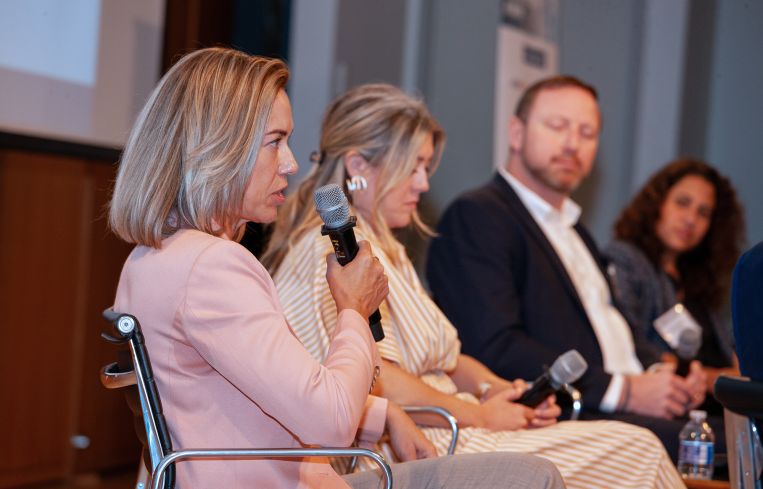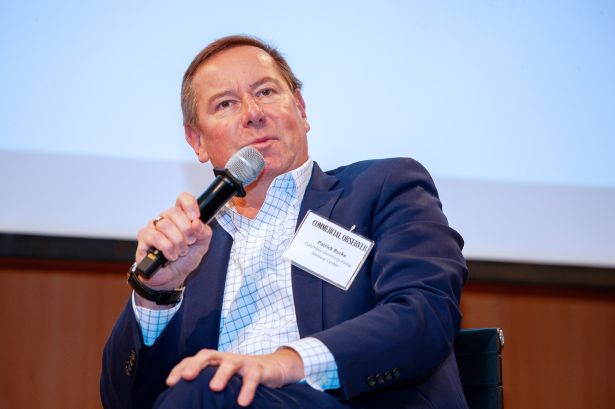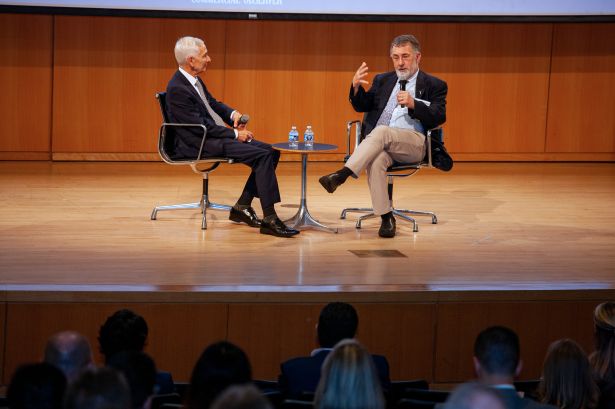Health Care Construction Industry Looks to Innovate Amid Funding, Cost Challenges
A recent Commercial Observer forum assembled experts in the field, who agreed that a renewed focus on talent and planning were key
By Celia Young September 19, 2025 10:24 am
reprints
Building new health care facilities is like treating a patient: It requires a stellar team, a lot of communication, and, often, a whole lot of money.
That was the prognosis of a slate of panelists at Commercial Observer’s National Health Care Construction Forum, held Sept. 17 at the City University of New York Graduate Center. But industry leaders in health care, architecture, construction and design agreed that when it comes to funding, the industry was facing serious challenges from steeper tariffs and cutbacks to public health care programs.
While the group’s diagnosis wasn’t always sunny, the event, kicked off by Michael Garner, New York City’s chief business diversity officer, began with some optimism. The health care industry is finding new ways to build energy-efficient, all-electric hospitals, said Walt Vernon, CEO and founder of the Sextant Foundation, in a Q&A session with Mitch Green, senior vice president at construction firm AECOM Tishman.
All-electric hospitals — like Columbia University’s new biomedical research building in Washington Heights — aren’t just a “new fad” in the industry, but a viable option for rural communities, Vernon said. He gave the example of Klickitat Valley Health in Goldendale, Wash., where he helped install a hydrogen fuel cell to power the hospital — against the warnings of his partners.
“All my partners said, ‘You’re an idiot. … Think of the liability. You’re going to design the Hindenburg and blow up a hospital,’” Vernon said.
Thankfully, Vernon did not design another Hindenburg blimp. With the help of a grant, Klickitat Valley Health successfully installed the fuel cell and it’s now up and running, “showing the rest of us, in a way, what is possible,” Vernon added.
Building a shiny, new hospital is great, but in the next panel, moderated by Andrew Weinberg, director of business development for LF Driscoll Healthcare, experts focused on the need to repair existing infrastructure alongside eye-catching projects.
“I half joke that we have to have ribbon cuttings for chiller and boiler projects with a donor plaque right next to it that nobody will see,” said Daniel Ahn, vice president of planning and design at Catholic Health.

Chris Korsh, senior health care design leader at Gensler, wholeheartedly agreed. “You can’t operate your facility without strong and robust infrastructure,” he said.
But, at the same time, “nobody is wowed by the infrastructure investment strategy you’re trying to push,” added David Kontra, senior director of real estate for the Children’s Hospital of Philadelphia.
Those infrastructure investments don’t come cheap, and health care systems are already dealing with “unprecedented challenges” as they face cuts to Medicaid funding, Korsh said. Tariffs and supply chain issues make it even more important that developers look at project costs, said Mark Csontos, strategic project manager at Gil-Bar Health & Life Sciences.
A shaky economic environment, Medicaid cuts, and lower National Institutes of Health (NIH) funding all threaten to hamper revenue at the Children’s Hospital of Philadelphia, which in turn could limit its ability to free up capital for infrastructure projects, Kontra said. That makes early planning for projects even more crucial.
“Our biggest concern in this fiscal year is reimbursement rates, particularly Medicaid cuts and the continued threat of not getting the NIH funding that we were counting on,” Kontra said. “The key is really knowing what you’re going to spend, and having that thoughtful plan up front over a period of time.”
To execute that plan, developers and hospital networks need a star-studded team. And the next panel, discussing Columbia University’s biomedical research building, showcased just that.
Patrick Burke, vice president of facilities management, operations and planning at Columbia University Irving Medical Center, credited Joseph Chin, senior vice president of health care at LF Driscoll Healthcare, for keeping the complex project on track — even after the Italian heat pumps the team had planned to install were hit by tariffs.
“The team has responded spectacularly to the challenge,” Burke said at the panel, where he was joined by Richard Meilan, senior executive director at MG Engineering DPC, and Georgina Lalli, senior associate principal at architecture firm KPF.
Columbia’s all-electric building at 167th Street and Audubon Avenue is “both a shiny object, and an infrastructure project,” said Lalli. The all-electric wing had to be attached to Columbia’s existing nursing school and Russ Berrie Medical Science Pavilion building next door, which, as a bonus, will help bring the site in compliance with the city’s carbon emissions caps under Local Law 97, Burke said.
Working closely with federal and local governments to help fund these projects — and to make sure utility companies can power them — is crucial, Burke added.
That was particularly true for the case study in the next panel, where professionals discussed building the Kenneth C. Griffin Pavilion at Memorial Sloan Kettering (MSK) Cancer Center, moderated by Christopher Prochner, senior vice president at Cumming Group, a project management firm.
“An approach we took was to really try to be proactive and make relationships with agencies in advance, not after the storm has hit,” said Ryan Kiefer, associate director at MSK. “I think a lot of that kind of proactive communication really helped not put us in any crisis points.”
Early communication within the project team was necessary given the complex nature of the development, which required demolishing nearby residential buildings, clearing a foundation wall, and working without disrupting MSK’s nearby operations, said Thomas Drumm, project executive at Consigli Construction.
But it wasn’t just the New York City Department of Buildings that needed talking to. The whole project team — including Terron Browne, project manager of design and construction at MSK; Jovana Kandic-Carlot, principal at CannonDesign; Daquan Sisco, senior project manager of design and construction at MSK; and Jason Tavarez, project executive at Turner Construction Company — agreed that communicating with local residents, hospital staff, and stakeholders is key to the project’s success.
The final two panels of the day covered how developers and operators can harness the power of artificial intelligence and public art to improve their projects.
When it came to AI, Kasia Mickowska, a project executive at Shawmut Design and Construction, and Gabriel Van Houten, senior director of construction planning, design and construction for Mount Sinai Health Systems, said both of their firms were already using AI as part of their business. Van Houten was using it to search through multiple documents at once, while Mickowska said Shawmut was piloting an agent that could inform staffers how past problems in individual projects had been solved. But the real gains, Mickowska said, would come after training an AI model on Shawmut’s data.

“We’re in a data collection frenzy right now,” Mickowska said. “We have about 10 years of data collection for various markets. … We’re on the cusp of deploying this into a potentially predictive, analytical tool. It’s very exciting.”
One audience member asked whether AI threatened their job. To Dareen Salama, co-founder and CEO of AI data company Gryps, the answer was no — as long as you’re willing to learn about AI.
“AI is a tool and it can provide a lot, if you know your job well and you’re good at it,” said Salama at the panel, which was moderated by Tannenbaum Helpern Partner Brandon Reiner and included Edward Borman, vice president of the health care division at Allan Briteway Electrical Contractors, and Melissa Kiefer, vice president of facilities, development and regulatory affairs at the Hospital for Special Surgery.
“You’re going to transform your own job to be a lot more efficient and provide a lot more value,” Salama added.
Lastly, Larissa Trinder, assistant vice president of arts in medicine at NYC Health + Hospitals, and Deborah Morris, senior director of land use, planning, and real estate for NYC Health + Hospitals, talked about how public art can help hospitals retain staff.
NYC Health + Hospitals has 75 buildings and serves over 1 million patients every year, making it the nation’s largest public health care system, some of which includes affordable housing or public amenities, Morris said.
Inside those hospitals, the city displays its vast collection of art from famous artists such as Keith Haring and Andy Warhol, with the hope that art improves patient outcomes and limits clinician burnout, Trinder said at the panel moderated by Newmark Executive Managing Director Ira Rovitz.
“We know intrinsically that what art does is make us feel better,” Trinder said. “If we can prove that we are meaningfully addressing burnout, then that correlates with retention, and that correlates with better patient care. And we’ve been evaluating for several years.”


